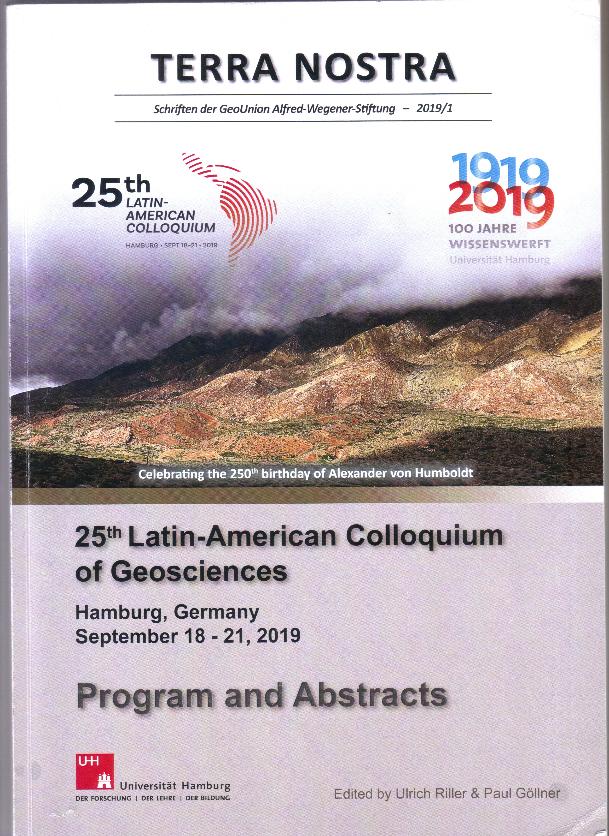Evento
Tortonian trachyte volcanoe in the Alta Sierra de Somún Curá Volcanic Complex: Northern Extrandean Patagonia. Argentina
Tipo del evento:
Congreso
Nombre del evento:
25th Latin American Colloquium of Geosciences
Fecha del evento:
10/2019
Institución Organizadora:
Universität Hamburg;
Título de la revista:
Terra Nostra
Editorial:
Universität Hamburg
ISSN:
0946-8978
Idioma:
Inglés
Clasificación temática:
Resumen
The Miocene Alta Sierra de Somún Curá Volcanic Complex (ASSCVC) is the northernmost post-plateau complex of the Somún Curá Magmatic Province (SCMP), at the northern extrandean Patagonia, Argentina (Fig. 1a, b). ASSCVC is made of several volcanic buildings which span the basaltic to trachyte realm. Monogenetic basaltic volcanoes (i.e. Cuatro Cerros), trachyte apparatus (i.e. Cerro Pancho) and polygenetic basaltic to trachyte constructions (i.e. Cerro Corona) compose the Complex. Four features distinguish ASSCVC from other post-plateau complexes of the SCMP: its age, it is the youngest of the post-plateau assemblages; the lack of a compositional gap between basaltic and trachyte terms; the absence of rhyolite differentiates and the presence of several emission centers associated with prominent volcanic constructions. This contribution deals with one of the chiefly trachyte volcanoes of ASSCVC. The polygenetic stratovolcano of Cerro Mimbre (CMTV), located in the southern complex (Fig. 1c), is the northernmost of three volcanoes arranged along a NW-SE trend. CMTV is set within a local low relief area dominated by volcanic landforms with general SE gentle slope. Two semicircular escarpments in the uppermost CMTV are compatible with an explosion crater. Associated loose deposits of white color and fine texture, located among coulées, are indicative of explosive eruptive facies. At least four lobular trachytic coulées emerge from the domes distributed in the CMTV; coulées locally preserve marginal ridges. Trachyte coulées include autobrecciated facies of porphyric texture with anorthoclase phenocrysts and minor ferromagnesian minerals. Groundmass is trachytic composed of sanidine microliths and clinopyroxene.Trachyte lava flows are porphyric with feldspar phenocrysts (of oligoclase to anorthoclase composition) set in a trachyte groundmass with some bostonitic patches. Microliths of anorthoclase to sanidine composition, olivine, clinopyroxene (Mg-rich augite), F-apatite and magnetite complete the groundmass assemblage.Two long basaltic flows extend for several kilometers enveloping the CMTV. Three scoria cones surround the CMTV; within the main crater, there are two oxidized deposits of scoria that would correspond to a very eroded cone, younger than the trachyte coulées. The lowermost basaltic flows surrounding the main volcanic building are vesicle rich, either aphyric or porphyritic with plagioclase phenocrysts and olivine microphenocrysts set in an intergranular groundmass with ophitic patches made of clinopyroxene and plagioclase.Trachyte flows of the CMTV yielded a new whole rock K/Ar age (Fig. 1d) of 9.8 ± 0.3 Ma, which fits well (within errors) with already published chronological data for other trachyte lavas of ASSCVC ( 9-13 Ma).
Palabras clave:
VOLCANISM
,
EXTRA ANDEAN PATAGONIA
,
ARGENTINA
Archivos asociados
Licencia
Identificadores
Colecciones
Eventos(UNIDEF)
Eventos de UNIDAD DE INVESTIGACION Y DESARROLLO ESTRATEGICOS PARA LA DEFENSA
Eventos de UNIDAD DE INVESTIGACION Y DESARROLLO ESTRATEGICOS PARA LA DEFENSA
Citación
Tortonian trachyte volcanoe in the Alta Sierra de Somún Curá Volcanic Complex: Northern Extrandean Patagonia. Argentina; 25th Latin American Colloquium of Geosciences; Hamburg; Alemania; 2019; 1-2
Compartir




